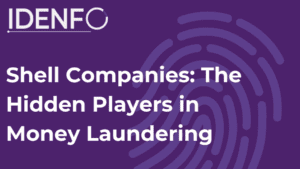Money laundering remains one of the most pervasive challenges in global financial systems, with criminals constantly evolving their methods to circumvent anti-money laundering (AML) controls. At the heart of these illicit activities lies a critical process known as “layering” – the second phase in the 3 stages of money laundering that transforms dirty money into seemingly legitimate assets. This blog examines the intricacies of layering, its role in the money laundering lifecycle, and how modern compliance solutions like those offered by IDENFO MENA are revolutionizing the fight against financial crime.
The Three Stages of Money Laundering: A Framework for Financial Crime
To fully grasp the significance of layering, one must first understand its position within the broader context of the 3 stages of money laundering. This tripartite process – comprising placement, layering, and integration – forms the backbone of most money laundering operations, creating a systematic approach to legitimizing illicit funds.
Placement: The Entry Point for Illicit Funds
The first of the money laundering stages involves introducing illegally obtained funds into the financial system. Criminals employ various techniques during this phase, including:
- Structuring small deposits to avoid reporting thresholds
- Purchasing high-value assets with cash
- Using currency exchanges or prepaid cards
- Commingling illicit funds with legitimate business revenues
Financial institutions remain most vulnerable during the placement stage, as sudden cash inflows or unusual transaction patterns can trigger compliance alerts. However, successful placement sets the stage for more sophisticated laundering activities.
Layering: The Art of Financial Obfuscation
As the second of the 3 stages of money laundering, layering serves as the critical bridge between initial fund placement and final integration. This phase involves creating complex transaction networks to obscure the money's origin through:
- Cross-border wire transfers between multiple jurisdictions
- Conversion of cash into different asset classes
- Use of shell companies and offshore accounts
- Fabricated invoices for fictitious goods/services
Integration: Reintroducing “Clean” Capital
The final phase in the money laundering stages sees laundered funds re-enter the legitimate economy through:
- Real estate purchases
- Business investments
- Luxury asset acquisitions
- Stock market transactions
By this stage, the money appears fully legitimized, making detection exceptionally challenging without advanced analytical tools.
Deconstructing the Layering Process: Methods and Mechanisms
Layering represents the most technically complex of the 3 stages of money laundering, employing various financial instruments and geopolitical strategies to create impenetrable audit trails.
Core Objectives of Layering
This phase serves three primary functions:
- Source Obfuscation: Severing the connection between funds and their criminal origins
- Asset Transformation: Converting cash into less traceable instruments like cryptocurrencies or precious metals
- Jurisdictional Complexity: Exploiting international banking systems and regulatory arbitrage
A 2024 Interpol analysis of 120 high-profile cases found that the average layering scheme involved transactions across 7.3 countries and 14.6 financial institutions.
Common Layering Techniques
Modern money launderers employ an array of sophisticated layering methods:
Electronic Funds Obfuscation
- Chain transfers through multiple correspondent banks
- Cryptocurrency tumblers and privacy coins
- Automated clearing house (ACH) payment loops
Asset Conversion Strategies
- Purchase and resale of high-value art/antiques
- Commodity futures trading
- Insurance product investments
Corporate Veil Tactics
- Layered ownership structures using offshore shell companies
- False invoicing between related entities
- Artificial loan arrangements
Geographic Dispersion
- Exploiting jurisdictions with weak AML controls
- Using alternative remittance systems like Hawala
- Cycling funds through tax havens
The Challenges of Detecting Layered Transactions
Layering poses unique detection challenges that test the limits of conventional AML systems:
Jurisdictional Fragmentation
With 78% of layering schemes involving cross-border transactions (World Bank 2024), investigators face:
- Conflicting legal frameworks
- Language/coordination barriers
- Varying data privacy laws
Transactional Complexity
A single layering operation might involve:
- 15+ intermediary accounts
- 3+ currency conversions
- Multiple asset class transformations
Evolving Financial Technologies
Emerging tools like decentralized finance (DeFi) platforms and AI-powered trading bots provide new avenues for sophisticated layering schemes.
Combating Layering: AML Strategies and Technological Solutions
Addressing the challenges posed by layering requires a multi-layered defense strategy incorporating both procedural controls and advanced technologies.
Foundational AML Measures
- Customer Due Diligence (CDD): Implementing rigorous Know Your Customer (KYC) protocols
- Transaction Monitoring: Establishing thresholds for unusual activity reporting
- Sanctions Screening: Real-time checks against global watchlists
Advanced Detection Technologies
IDENFO MENA's compliance platform incorporates cutting-edge features to combat layering:
- Biometric Verification: Facial recognition and liveness detection to prevent synthetic identities
- Document Authentication: AI-powered analysis of IDs/payment instruments
- Network Analysis: Mapping transactional relationships across entities
- Behavioral Analytics: Machine learning models detecting subtle pattern shifts[Company Info]
Regulatory Collaboration
Effective layering detection requires public-private partnerships:
- Shared typology databases
- Joint task forces targeting cross-border schemes
- Harmonized reporting standards
The Future of Layering Detection: AI and Beyond
As layering techniques grow in sophistication, next-generation solutions are emerging:
Predictive Analytics
- Machine learning models forecasting potential layering routes
- Natural language processing of corporate registries
Blockchain Forensics
- Tracking cryptocurrency flows across mixed wallets
- Identifying cluster relationships in distributed ledgers
Quantum Computing
- Processing complex transactional networks in real-time
- Breaking encryption on obscured ownership structures
IDENFO MENA's R&D pipeline includes quantum-resistant algorithms and decentralized identity verification protocols to stay ahead of evolving threats.
Breaking the Layering Chain
Understanding layering's role in the 3 stages of money laundering is crucial for developing effective AML defenses. As criminals continue innovating their methods, solutions like IDENFO MENA's end-to-end compliance platform provide essential tools for:
- Real-time transaction monitoring
- Cross-jurisdictional pattern recognition
- Automated regulatory reporting
- Adaptive risk scoring
By combining technological innovation with robust procedural controls, financial institutions can disrupt the layering process before funds reach the integration stage. In doing so, they protect not just their own operations, but the integrity of the global financial system itself.







